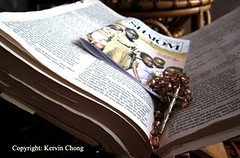Lectio Divina: The Art of Divine Reading

Lectio divina, or the art of sacred reading, has been around a very, very long time. It means a slow and contemplative praying of the Bible, which very soon allows God to touch our hearts with His Word.
Reading (lectio)
Bible study and reading through the Bible are necessary disciplines to grow as a Christian. But lectio divina is neither a study nor a methodical reading through of the Bible. In lectio, you very slowly read a passage of Scripture in order to hear what God is staying to you in a still, still, small voice (I Kings 19:12). Sometimes God can talk very loudly! But more often he speaks very softly, and we have to turn to him and pay some attention to hear. It makes sense if we are always talking or always surround ourselves with noise, how can we hear a “still, small voice?” In lectio, you may not make it past the third word before you stop and listen to God speaking to you personally, giving you the word or phrase for each day. This is why you should probably not try to make lectio your reading-through-the-Bible-in-a-year plan!
Meditation (meditatio)
When we find a word, phrase or a passage in the Bible (or God finds it for us!) that speaks to us in a personal way, it’s time to meditate on it. This is not the meditation of Bible study, but of sitting quietly and considering it, chewing it over. In fact, the image of the peacefully chewing cow as a symbol of a meditative Christian was common in the early church! We read, gently repeat, and memorize the passage that God has brought to us. We wrap our hopes and wants and fears and desires around it, and God speaks His Word to our inner hearts and minds.
Prayer (oratio)
When we pray during lectio, we are lifting up our meditative experience to him. We speak the word or phrase to him as a prayer. In meditation we considered how the Word impacts our challenges and dreams, and we lift that up to God s as well as we speak his Word over them. Just as taking Communion reminds us of Christ’s body and blood broken and shed for us, we hold up to God our challenges and pain, and gently say the healing word over them. This kind of prayer doesn’t ask for clever wording on our part and pious turns of phrase, but uses God’s own Word and speaks back to him and the hurting places in ourselves.
Contemplation: (contemplatio)
Now it’s time to be silent in the presence of God. Use this time to practice the Prayer of Silence: imaging prayer or imageless prayer. Imaging silent prayer starts with an image in your imagination. Invite the Holy Spirit to enter this space, then see what He has to say to you. This is not a daydream or a visualization: the Holy Spirit runs teh show. Imageless silent prayer is going into silence and opening yourself to receive the felt, mighty presence of God. Enjoy just being with God.
Lectio divina is most often done privately, but can also be done in a group. My beloved Mom practiced lectio both privately and in a weekly group for years before she went home to be with God. Group lectio should not replace your personal time with God, but can be a wonderful and strengthening spiritual practice.
Part of this article was adapted from Fr. Luke Dysinger, O.S.B.’s wonderful teaching on lectio divina, “Accepting the Embrace of God: The Ancient Art of Lectio Divina.”


One Comment
Pingback: